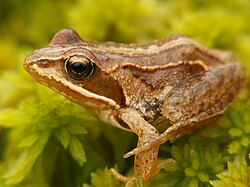You can help expand this article with text translated from the corresponding article in French. Click [show] for important translation instructions.
|
Amphibians of Metropolitan France include:
You can help expand this article with text translated from the corresponding article in French. Click [show] for important translation instructions.
|
Amphibians of Metropolitan France include:
| Common name | Scientific name | Range | IUCN status (France) | IUCN status (worldwide) | Refs. |
|---|---|---|---|---|---|
Edible frog  | Pelophylax kl. esculentus (Linnaeus, 1758) | NT | LC | [1] | |
Graf's hybrid frog  | Pelophylax kl. grafi (Crochet, Dubois, Ohler & Tunner, 1995) |  | NT | NE | [1] |
Pool frog  | Pelophylax lessonae (Camerano, 1882) | NT | LC | [1] | |
Perez's frog  | Pelophylax perezi (López-Seoane , 1885) |  | NT | LC | [1] |
Marsh frog  | Pelophylax ridibundus (Pallas, 1771) |  | LC | LC | [1] |
Moor frog  | Rana arvalis Nilsson, 1842 |  | EN | LC | [1] |
Agile frog  | Rana dalmatina Fitzinger in Bonaparte, 1839 |  | LC | LC | [1] |
Pyrenean frog  | Rana pyrenaica Serra-Cobo, 1993 | EN | EN | [1] | |
Common frog  | Rana temporaria Linnaeus, 1758 |  | LC | LC | [1] |